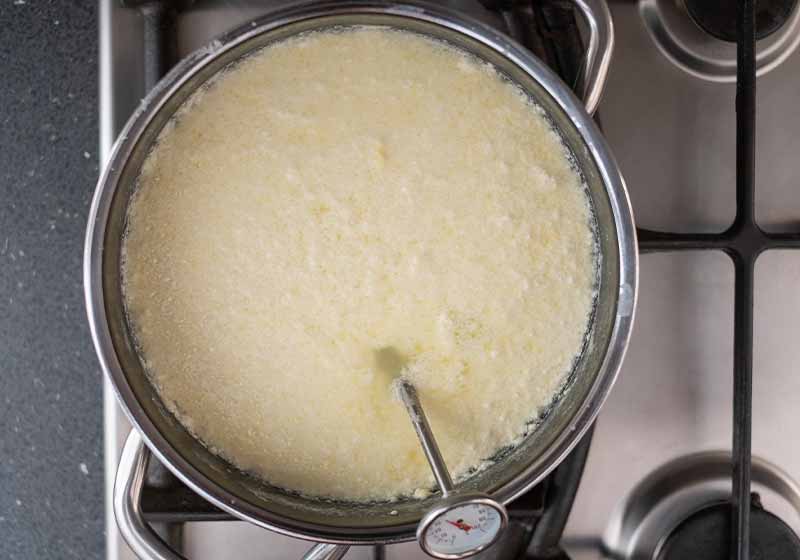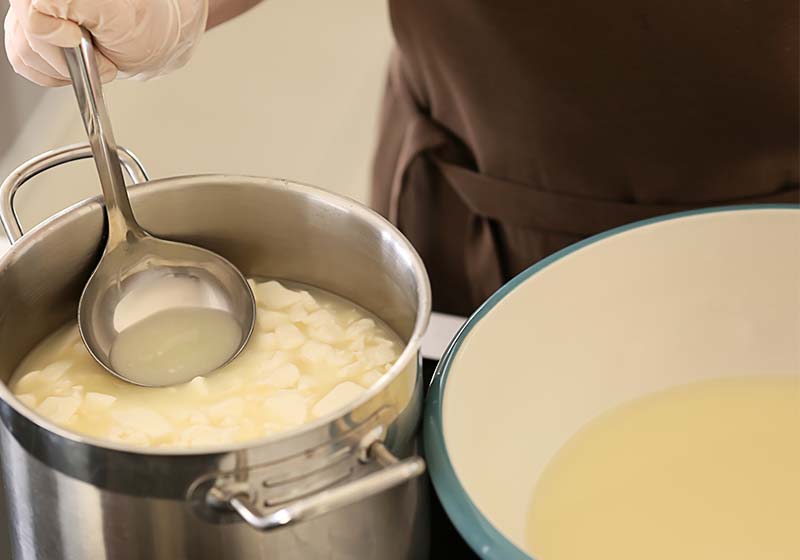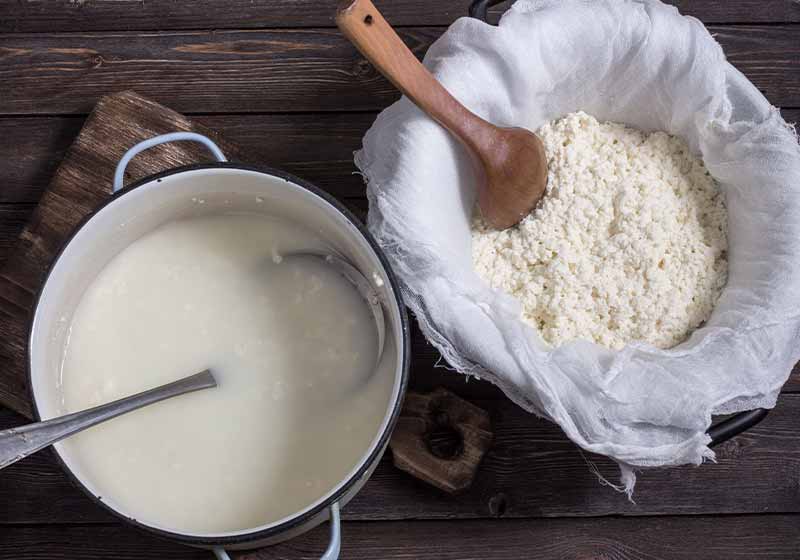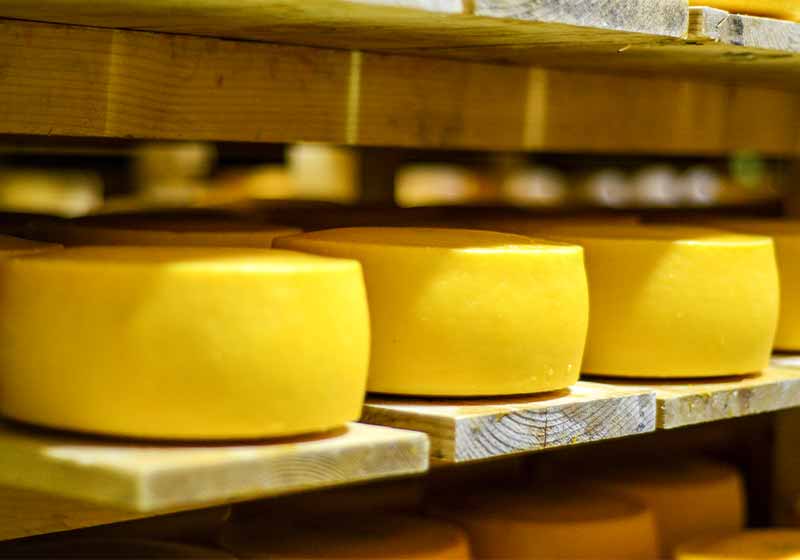Every cheese-loving homesteader should know how to make Gouda cheese. This way, you have a constant homemade supply of this creamy and buttery goodness.
Learn with us how to in this detailed guide.
RELATED: How To Make Vegetable Rennet for Cheesemaking
How to Make Gouda Cheese at Home | Step by Step Guide
Ingredients
- 2 gallons whole milk
- 1 packet mesophilic culture
- 1 tbsp. calcium chloride diluted in 1/4 cup water
- 1/2 tsp. Rennet diluted in 1/4 cup cool, unchlorinated water
- 1 gallon cold water
- 2 pounds cheese salt for a brine solution
- Cheese wax (optional)
Equipment You'll Need
- Stove
- Deep saucepot
- Instant-read thermometer
- Stirring spoon
- Palette knife
- Ladle
- Colander
- Cheesecloths
- Cheese mold with follower press
- Drying mat
No products found.
Step 1. Culturing the Raw Milk

Thoroughly wash all the equipment you will be using in soapy water, rinse, and dry them. If you like, spray diluted white vinegar to sanitize the equipment, and leave it to dry.
Turn on the stove and let the milk attain a steady temperature of 29°C. Turn off the heat and sprinkle the Mesophilic culture on the milk's surface.
Once the culture has set on the milk's surface for a while, stir it into the milk in up and down motions for a minute or two.
Next, thoroughly stir in the diluted Calcium Chloride solution into the milk solution.
Add the Rennet solution and stir for about one minute. Cover the mixture and allow it to sit for at least 40 minutes.
Tip: Check every five minutes until you have clean breaks.
Step 2. Cutting the Curd

Once you have clean breaks after the 40 minutes of resting, use a palette knife to cut the curd into half-inch cubes and allow the cubes five minutes to seal the cuts.
Once they healed or sealed, give the cubes a gentle stir and let the curd cubes sit undisturbed for five minutes.
You will know you are on the right track when the half-inch cubes sink in the whey after setting.
Step 3. Washing the Curd

Using a ladle, scoop out about a tenth of the whey and replace it with an equal amount of 60°C water to bring the overall temperature up to 33°C. Please give it a gentle but continuous stir, and rest for about 10 minutes.
Next, scoop out the remaining whey to the level of the curds. Using your stirring spoon, gently stir to break up the curd mass and replace the drained whey with 45°C water to get the overall temperature to 37°C.
Continue stirring the curd for another 20 minutes until it shrinks, and then allow it to settle for 10 minutes.
Tips
- Add more cool water to bring the temperature down in case it raises too high.
- The curd should mat into a large mass after allowing it to sit undisturbed.
RELATED: Homemade Mozzarella: How To Make Mozzarella At Home
Step 4. Pressing and Brining the Cheese

Line a colander with cheesecloth and pour the curd and whey mixture. When the whey drains, further break the chunks to release as much whey as possible.
Once all the whey has drained, line your mold with another cheesecloth and transfer your drained curd into the mold. Fold one corner of the cheesecloth over the mold such that it covers the upper surface of the curd and then lay a follower.
When in place, press at 10 kg for 30 minutes. Then, remove the cheese from the mold, flip it, redress, and press it again at 13 kg for 12 hours.
In a separate container, dissolve the cheese salt in the water to form a brine. Take the cheese out of the press and mold, unwrap the cheesecloth and submerge the cheese in the brine for 12 hours, flipping it every six hours to ensure even coverage.
- GRADE 90 CHEESECLOTH - 100% Grade 90 cheesecloth is much...
- 100% UNBLEACHED COTTON - Premium natural unbleached cotton...
Step 5. Air-drying and Maturation

Remove the cheese from the brine and pat dry. Air-dry the cheese on a cheese mat at room temperature for a few days to a week.
If you want, wax the cheese with at least three-cheese wax layers and ripen for up to nine months at 12°C.
Pro Tips
- For better drying, ensure you turn the cheese several times a day.
- The flavor of Gouda cheese grows stronger with age, which will dictate how long you should allow it to age.
- Freezing any type of cheese alters the flavor and leads to a crumbly texture.
- In case you wax your cheese, expect the color of the waxy rind to get darker as the cheese ages.
- Gouda cheese will blend well with your Thanksgiving vegetable salads.
Looking for a vegan gouda recipe? Watch this video from 86eats for easy gouda cheese recipe:
Store-bought cheese can be expensive, especially if you consume it frequently. However, with this detailed guide, you can easily make your own homemade Gouda cheese at almost half the price.
How do you like your Gouda cheese? Let us know in the comment section below!
Up Next:
- How To Make Cream Cheese At Home
- 3 Gluten-Free Sourdough Bread Recipes
- Stress Relieving Lavender Candles You Can Make At Home
Fellow homesteaders, do you want to help others learn from your journey by becoming one of our original contributors? Write for us!

I love the recipes but wish they were in recipe format so I could print out without all the pictures.